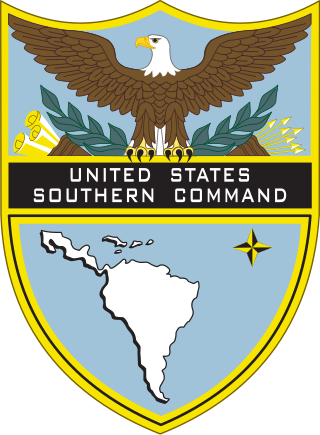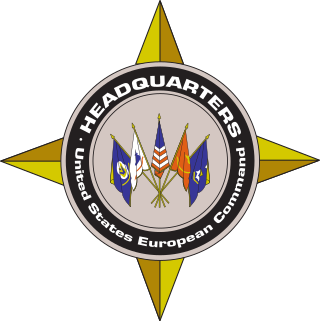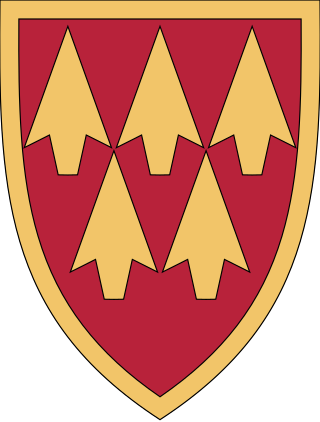
The United States Army Pacific (USARPAC) is an Army Service Component Command (ASCC) designated by the Secretary of the Army (SECARMY); it may also serve as a Joint Task Force headquarters. It is the army component unit of the United States Indo-Pacific Command, and its mission is to support the Commander, United States Indo-Pacific Command. The main areas that this command has jurisdiction in include Alaska, Hawaii, the Pacific Ocean, Japan, and South Korea. It also performs missions in Southeast Asia, in the countries stretching from the Philippines all the way to Bangladesh and India. United States Forces Korea (USFK) has had operational command and control of US Forces in Korea since January 2012, and USARPAC headquarters oversees the manning, training, and equipping of US Army forces assigned to USFK.

The United States Central Command is one of the eleven unified combatant commands of the U.S. Department of Defense. It was established in 1983, taking over the previous responsibilities of the Rapid Deployment Joint Task Force (RDJTF).

The United States Second Fleet is a numbered fleet in the United States Navy responsible for operations in the East Coast and North Atlantic Ocean. Established after World War II, Second Fleet was deactivated in 2011, when the United States government believed that Russia's military threat had diminished, and reestablished in 2018 amid renewed tensions between NATO and Russia.

The United States Space Command is a unified combatant command of the United States Department of Defense, responsible for military operations in outer space, specifically all operations 100 kilometers and greater above mean sea level. U.S. Space Command is responsible for the operational employment of space forces that are provided by the uniformed services of the Department of Defense.

The United States Indo-Pacific Command (USINDOPACOM) is the unified combatant command of the United States Armed Forces responsible for the Indo-Pacific region.

The United States Transportation Command (USTRANSCOM) is one of the eleven unified commands of the United States Department of Defense. In both times of peace and war, USTRANSCOM's role is to provide the Department of Defense with air, land, and sea transportation. USTRANSCOM was founded in 1987 and is based at Scott Air Force Base in Illinois.

The United States Southern Command (USSOUTHCOM), located in Doral, Florida in Greater Miami, is one of the eleven unified combatant commands in the United States Department of Defense. It is responsible for providing contingency planning, operations, and security cooperation for Central and South America, the Caribbean, their territorial waters, and for the force protection of U.S. military resources at these locations. USSOUTHCOM is also responsible for ensuring the defense of the Panama Canal and the canal area.

The United States Joint Forces Command (USJFCOM) was a Unified Combatant Command of the United States Department of Defense. USJFCOM was a functional command that provided specific services to the military. The last commander was Army Gen. Ray Odierno and the Command Senior Enlisted was Marine Sergeant Major Bryan B. Battaglia. As directed by the President to identify opportunities to cut costs and rebalance priorities, Defense Secretary Robert Gates recommended that USJFCOM be disestablished and its essential functions reassigned to other unified combatant commands. Formal disestablishment occurred on 4 August 2011.

The United States European Command (EUCOM) is one of the eleven unified combatant commands of the United States military, headquartered in Stuttgart, Germany. Its area of focus covers 21,000,000 square miles (54,000,000 km2) and 51 countries and territories, including Europe, The Caucasus, Russia and Greenland. The Commander of the United States EUCOM simultaneously serves as the Supreme Allied Commander, Europe (SACEUR) within NATO, a military alliance. During the Gulf War and Operation Northern Watch, EUCOM controlled the forces flying from Incirlik Air Base.
A unified combatant command, also referred to as a combatant command (CCMD), is a joint military command of the United States Department of Defense that is composed of units from two or more service branches of the United States Armed Forces, and conducts broad and continuing missions. There are currently 11 unified combatant commands, and each is established as the highest echelon of military commands, in order to provide effective command and control of all U.S. military forces, regardless of branch of service, during peace or during war time. Unified combatant commands are organized either on a geographical basis or on a functional basis, e.g., special operations, force projection, transport, and cybersecurity. Currently, seven combatant commands are designated as geographical, and four are designated as functional. Unified combatant commands are "joint" commands and have specific badges denoting their affiliation.

Joint Functional Component Command for Integrated Missile Defense is a component of United States Space Command (USSPACECOM). The current commander is Army Lieutenant General Daniel L. Karbler.

The 607th Combat Weather Squadron of the U.S. Air Force has overall responsibility for planning, providing, and/or arranging weather support for the United States Army during armistice conditions in Korea. 607 CWS and elements of the US Navy and US Marines support the Republic of Korea Air Force (ROKAF) Weather Wing, Combined Meteorological and Oceanographic (METOC) Officer (CMO) and subordinate squadrons during exercises and contingencies. The 607 CWS commander is also the Joint METOC Officer (JMO) and the senior US METOC officer (SMO) for the Korean Theater of Operations (KTO).

The United States Africa Command is one of the eleven unified combatant commands of the United States Department of Defense, headquartered at Kelley Barracks, Stuttgart, Germany. It is responsible for U.S. military operations, including fighting regional conflicts and maintaining military relations with 53 African nations. Its area of responsibility covers all of Africa except Egypt, which is within the area of responsibility of the United States Central Command. U.S. AFRICOM headquarters operating budget was $276 million in fiscal year 2012.
Area of responsibility (AOR) is a pre-defined geographic region assigned to Combatant commanders of the Unified Command Plan (UCP), that are used to define an area with specific geographic boundaries where they have the authority to plan and conduct operations; for which a force, or component commander bears a certain responsibility. The term may also be used in other countries worldwide but it originated within the United States Armed Forces. This system is designed to allow a single commander to exercise command and control of all military forces in the AOR, regardless of their branch of service.

The Commander, U.S. Marine Corps Forces Command (COMMARFORCOM), headquartered at the Naval Support Activity Hampton Roads in Norfolk, Virginia, commands service retained-operating forces; executes force sourcing and synchronization to affect force generation actions in the provisioning of joint capable Marine Corps forces, and directs deployment planning and execution of service retained-operating forces in support of Combatant Commander (CCDR) and service requirements; serves as Commanding General, Fleet Marine Force, Atlantic and commands embarked Marine Corps forces; coordinates Marine Corps-Navy integration of operational initiatives and advises CDR U.S. Fleet Forces Command (USFF) on support to Marine Corps forces assigned to naval ships, bases, and installations; conducts Service directed operational tasks as required. COMMARFORCOM is also the Commander, Marine Corps Forces Northern Command (MARFORNORTH), the Marine service component command of U.S. Northern Command.

The Special Operations Command Korea or SOCKOR, the United States (U.S.) Theater Special Operations Command (TSOC) in the Republic of Korea (ROK), is a Sub-Unified Command assigned under the Combatant Command (CCMD) of United States Special Operations Command (USSOCOM), who delegated Operational Command (OPCON) of SOCKOR to the U.S. Indo-Pacific Command (USINDOPACOM) Commander, who further delegated OPCON of SOCKOR to the United States Forces Korea (USFK) Commander.

The 32nd AAMDC or 32nd Army Air and Missile Defense Command is a theater level Army air and missile defense multi-component organization with a worldwide, 72-hour deployment mission. The 32nd AAMDC commands echelon above corps (EAC) ADA brigades and other assigned forces. Four such brigades, 11th Air Defense Artillery Brigade, 31st Air Defense Artillery Brigade, 69th Air Defense Artillery Brigade, and 108th Air Defense Artillery Brigade; by training, all stand ready to accomplish their mission of air defense against missile attack – 'anywhere, anytime' in support of the war-fighting combatant commander (CCDR).
Mission Command Training Program, based at Fort Leavenworth, Kansas, is the U.S. Army's only worldwide deployable Combat Training Center. MCTP provides full spectrum operations training support for senior commanders and their staffs so they can be successful in any mission in any operational environment. Its Senior Mentors counsel and offer their experience to Army senior commanders, subordinate commanders and staff. Additionally, MCTP's professional observer-trainers assist units with objective feedback and suggestions for improvement.

403d Army Field Support Brigade (AFSB), headquartered at Camp Henry, Daegu, Republic of Korea, delivers U.S. Army Materiel Enterprise to supported forces throughout the Korean and Japanese Theaters of Operations.
The Joint Operations Headquarters is the Italian joint operational command directly reporting to the Chief of the Defence Staff. This command exercises the planning, coordination and direction of the military operations of the Italian armed forces, and on joint and multinational exercises and all activities connected to them. Through the COVI, the Chief of the Defence Staff is able to exercise his functions as Operational Commander of the Armed Forces.















